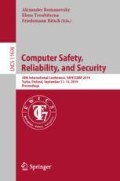Abstract
In recent years, interest in autonomous systems has increased. To observe their environment and interact with it, such systems need to process sensor data including camera images. State-of-the-art methods for object recognition and image segmentation rely on complex data-driven models such as convolutional neural networks. Although no final answer exists yet on how to perform safety evaluation of systems containing such models, such evaluation should comprise at least validation with realistic input data, including settings with suboptimal data quality. Because many test datasets still lack a sufficient number of representative quality deficits, we consider augmenting existing data with quality deficits as necessary. For this purpose, a novel tool framework is presented and illustrated using traffic sign recognition as a use case. The extendable approach distinguishes between augmentation at the object, context, and sensor levels. To provide realistic augmentation and meta-data for existing image datasets, known context information and conditional probabilities are processed. First applications on the GTSRB dataset show promising results. The augmentation of datasets facilitates a more rigorous investigation of how various quality deficits affect the accuracy of a model in its target application scope.
Access this chapter
Tax calculation will be finalised at checkout
Purchases are for personal use only
References
German Traffic Sign Benchmarks. http://benchmark.ini.rub.de/?section=gtsrb. Accessed 19 Feb 2019
CrESt Project Website. https://crest.in.tum.de/. Accessed 19 Feb 2019
Krizhevsky, A., Sutskever, I., Hinton G.E.: ImageNet classification with deep convolutional neural networks. In: Advances in Neural Information Processing Systems (NIPS), vol. 25, pp. 1097–1105 (2012)
Ciresan, D., Meier, U., Schmidhuber, J.: Multi-column deep neural networks for image classification. In: Staff, I. (ed.) 2012 IEEE Conference on Computer Vision and Pattern Recognition, pp. 3642–3649. IEEE (2012)
Kläs, M.: Towards identifying and managing sources of uncertainty in AI and machine learning models - an overview. arxiv.org/pdf/1811.11669v1 (2018)
Dodge, S., Karam, L.: Understanding how image quality affects deep neural networks. arxiv.org/pdf/1604.04004v2 (2016)
Shrivastava, A., Pfister, T., Tuzel, O., et al.: Learning from simulated and unsupervised images through adversarial training. In: Conference on Computer Vision and Pattern Recognition (CVPR), Honolulu, Hawaii, pp. 2242–2251 (2017)
Goodfellow, I., Pouget-Abadie, J., Mirza, M., et al.: Generative adversarial nets. In: Advances in Neural Information Processing Systems (NIPS), vol. 27 (2014)
Wong, S.C., Gatt, A., Stamatescu, V., et al.: Understanding data augmentation for classification: when to warp? In: International Conference on Digital Image Computing: Techniques and Applications (DICTA) (2016)
Goodfellow, I.J., Shlens, J., Szegedy, C.: Explaining and Harnessing Adversarial Examples. arxiv.org/pdf/1412.6572v3 (2014)
Carlson, A., Skinner, K.A., Vasudevan, R., et al.: Modeling camera effects to improve visual learning from synthetic data. arxiv.org/pdf/1803.07721v6 (2018)
Karahan, S., Yildirum, M.K., Kirtac, K., et al.: How image degradations affect deep cnn-based face recognition? In: International Conference of the Biometrics Special Interest Group (BIOSIG), Darmstadt, Germany (2016)
Cheng, C.-H., Huang, C.-H., Nührenberg, G.: nn-dependability-kit: engineering neural networks for safety-critical Systems. arxiv.org/pdf/1811.06746v1 (2018)
Pezzementi, Z., Tabor, T., Yim, S., et al.: Putting image manipulations in context: robustness testing for safe perception. In: International Symposium on Safety, Security, and Rescue Robotics (SSRR) (2018)
Luan, F., Paris, S., Shechtman, E., et al.: Deep photo style transfer. arxiv.org/pdf/1703.07511v3 (2017)
Liu, M.-Y., Breuel, T., Kautz, J.: Unsupervised image-to-image translation networks. arxiv.org/abs/1703.00848v6 (2018)
UjjwalSaxena Automold - Road Augmentation Library. http://github.com/UjjwalSaxena/Automold–Road-Augmentation-Library. Accessed 26 Feb 2019
Temel, D., Kwon, G., Prabhushankar, M., et al.: CURE-TSR: challenging unreal and real environments for traffic sign recognition. arxiv.org/abs/1712.02463v2 (2018)
Harisubramanyabalaji, S.P., ur Réhman, S., Nyberg, M., Gustavsson, J.: Improving image classification robustness using predictive data augmentation. In: Gallina, B., Skavhaug, A., Schoitsch, E., Bitsch, F. (eds.) SAFECOMP 2018. LNCS, vol. 11094, pp. 548–561. Springer, Cham (2018). https://doi.org/10.1007/978-3-319-99229-7_49
Climate Data Center. https://cdc.dwd.de/portal/. Accessed 19 Feb 2019
OpenStreetMap. https://www.openstreetmap.de/. Accessed 19 Feb 2019
Kläs, M., Sembach, L.: Uncertainty wrappers for data-driven models – increase the transparency of AI/ML-based models through enrichment with dependable situation-aware uncertainty estimates. In: Workshop on Artificial Intelligence Safety Engineering (WAISE), Turku, Finland (2019)
Acknowledgments
Parts of this work have been funded by the German Federal Ministry of Education and Research (BMBF) under grant number 01IS16043E (CrESt).
Author information
Authors and Affiliations
Corresponding authors
Editor information
Editors and Affiliations
Rights and permissions
Copyright information
© 2019 Springer Nature Switzerland AG
About this paper
Cite this paper
Jöckel, L., Kläs, M. (2019). Increasing Trust in Data-Driven Model Validation. In: Romanovsky, A., Troubitsyna, E., Bitsch, F. (eds) Computer Safety, Reliability, and Security. SAFECOMP 2019. Lecture Notes in Computer Science(), vol 11698. Springer, Cham. https://doi.org/10.1007/978-3-030-26601-1_11
Download citation
DOI: https://doi.org/10.1007/978-3-030-26601-1_11
Published:
Publisher Name: Springer, Cham
Print ISBN: 978-3-030-26600-4
Online ISBN: 978-3-030-26601-1
eBook Packages: Computer ScienceComputer Science (R0)

